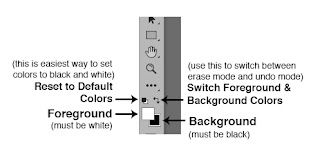Colorized Black and White Photographs
For
this assignment, you will be creating 15 colorized black and white
photographs. Each of these fifteen photographs should demonstrate understanding of the following color schemes:
- Complementary Colors (3 pictures for each complementary pair – 9 total)
- Analogous colors (3 pictures)
- Monochromatic colors (3 pictures)
Definitions
Complementary Colors – Colors opposite of each other on
the color wheel
- Red and Green
- Orange and Blue
- Yellow and Purple
Analogous colors – 3 or more colors that are next to
each other on the color wheel, for example: Red-Violet, Red, Red Orange, and Orange,
or Yellow-Green, Green, Blue-Green, Blue, and Blue violet
Monochromatic colors – 3 or more values of the same hue
Hue – What people typically think of as
“color” – red, orange, yellow, green, blue, and violet, or anything in between
Value – The darkness or lightness of hues
________________________________________________________________
Colorized Black and White Editing Tips:
Steps for doing colorized black and white photographs:
1. Open your photo. Add a black and white adjustment layer to your photograph
2. Use the eraser tool, use the shortcut "E" or click on this icon:

Colorized Black and White Editing Tips:
- Make sure that you are on your black and white layer when trying to colorize - if you are on the background layer, you may be accidentally deleting your image
- Make sure that you have WHITE as your FOREGROUND color and BLACK as your BACKGROUND color. If you want to erase your colorizing if you messed up, switch to the opposite (black as foreground, white as background).
- Make sure the opacity of your eraser (on the options bar) is turned all the way up to 100%
- Make sure the hardness of the edge of your brush is at 100%
- To zoom in and out - use cmnd+ (zoom in) and cmnd- (zoom out)
- To make your brush larger or smaller use [ (smaller) and ] (larger)
1. Open your photo. Add a black and white adjustment layer to your photograph
2. Use the eraser tool, use the shortcut "E" or click on this icon:

3. Make sure you have white as your Foreground color and black as your background color - to switch your foreground and background colors - to switch your foreground and background colors if they are opposite of what you want, like in the images below, click the arched arrow that is to the top right of the color swatches.
4. Make sure you have the black and white adjustment layer selected in your layers window, and begin to erase the areas you want to have color
5. If you accidentally colorize something outside of your subject, you can easily undo this by switching your foreground and background colors to black as the foreground and white as the background, and then erase the colorizing you didn't mean to do (see image above)
Examples:
Complementary - Orange and Blue
Complementary - Red and Green
Complementary - Yellow and Purple
Analogous
Monochromatic







No comments:
Post a Comment